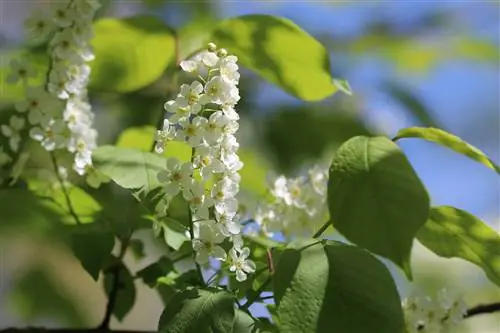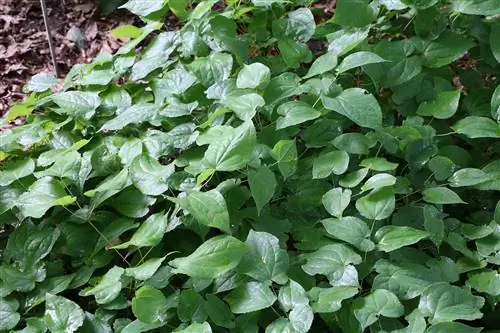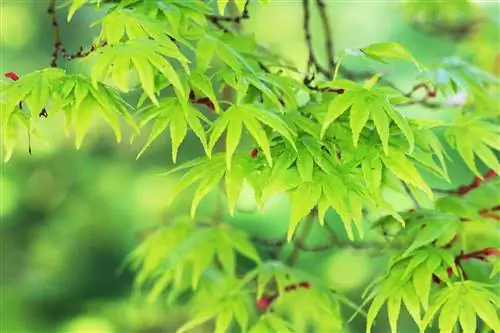- Author admin [email protected].
- Public 2023-12-17 03:39.
- Last modified 2025-01-24 12:45.
The wig bush (Cotinus coggygria) brings a rich color to your home garden during the autumn period with its bright red leaves. The ornamental shrub imported from the Mediterranean requires special care in our latitudes.
Location and soil
The wig bush, which comes from the Mediterranean, is a child of the sun. Although it is also possible to thrive in partially shaded places, it only reaches its full potential in a location flooded with light. In contrast, the plant is quite frugal when it comes to soil requirements. The shrub is extremely adaptable and is happy with almost all cultivated soils. However, well-drained, dry and nutrient-rich soils with a high lime content and medium nutrient content are preferred. In the case of heavy and compacted soils with a tendency to waterlogging, there is a tendency to develop verticillium wilt. This is a fungal disease that is usually fatal. The pH value is ideally between the values 6.5 and 7.5.
Tip:
A layer that serves as drainage, for example made of pottery shards, can minimize moisture.
Plants
Specimens from specialist retailers almost exclusively come from potted plants. If the container or pot is sufficiently rooted, nothing stands in the way of planting all year round. The situation is different with bushes cultivated outdoors, which should be planted outside the growing season.
Tip:
An ideal location should be chosen before planting. Shrubs that are already established are difficult to transplant without causing damage.
Generally speaking, spring is ideal for transplanting the plant. If temperatures are mild during the winter months, even autumn is suitable in these regions.
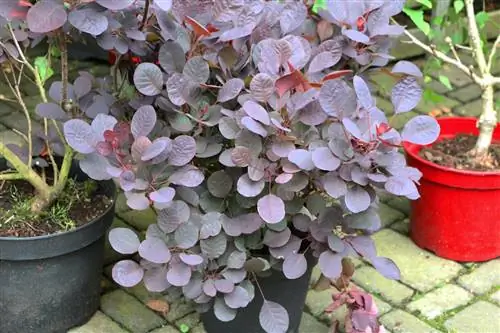
Of course, good soil conditions should always be present. Heavy and compacted soils can be improved with a dose of sand. The plant pit when planting the plant itself should be twice the diameter and twice the depth of the root ball. Before actually planting, the root ball should be loosened up for better growth and soaked generously in a bucket of water. After planting, the wig bush must be watered thoroughly.
Usage
The ornamental shrub is ideal as a solitary plant on open lawns. Its unique fruit cluster, which depends on the variety, as well as its leaves, which shine in different shades of red, attract everyone's attention in parks and gardens. Although the plant is ideal as a true stand-alone plant, the plant also looks great in combination with ornamental grasses, other colorful autumn trees or autumn perennials. The shrub also works well in large rock gardens or, due to its high resistance to drought, in roof gardens or on terraces in a container culture. The following plants are suitable as good planting partners:
- Marigolds
- Summerstars
- Jewelry basket
- Privet hedges
Propagation
Propagation can be done in different ways. The wig bush can be propagated in the traditional way by sowing during the spring months. However, this plan is not always successful. Propagation via lowering plants is more promising. This also happens in the spring. To do this, a large side shoot that reaches down to the ground must be lowered into the ground and firmly secured. At least 30 centimeters of the shoot tip should protrude from the soil. This sinker develops sufficient roots during the spring and summer growing season, allowing for separation from the parent plant and change of location. This type of propagation often happens completely involuntarily through the natural growth of the bush. These naturally formed sinkers can easily be cut off and replanted elsewhere in the garden for propagation.
Pouring
Watering the rather frugal wig tree according to a fixed schedule is rather counterproductive. Watering as needed makes more sense. This occurs when the earth's surface has dried to a depth of around 5 centimeters. The plant does not place high demands on irrigation water. Normal tap water is sufficient for watering. During extremely dry summer periods, it may be necessary to water several times per week. During dry months in spring, watering every two weeks is sufficient. Watering is done with a watering can or a garden hose. Irrigating the leaves and flowers should be avoided; the irrigation water should be applied directly to the tree disc.
Tip:
As a shallow-rooted plant, this shrub requires external irrigation in hot, dry periods. However, waterlogging is to be avoided at all costs. If there is a lack of water, this is signaled by limp leaves.
The optimal amount of water or water requirement depends on several factors such as the size of the plant, the nature of the soil and the prevailing temperatures. In general, infrequent watering with larger amounts daily is preferable. During the first year it may be necessary to give 10 to 20 liters of water every two weeks.
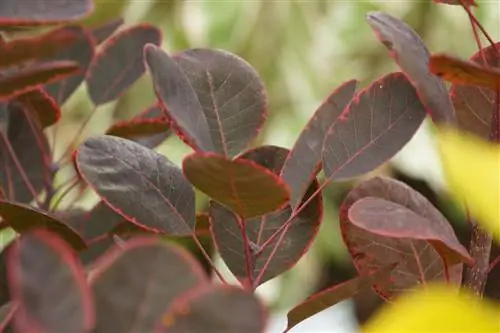
Fertilize
Even locations with a low supply of nutrients are sufficient for the wig bush. Accordingly, fertilizing this crop turns out to be quite uncomplicated. It is usually sufficient if the shrub is generously supplied with organic garden fertilizer or compost before its growing season in spring. Unlike most plants, the wig bush prefers mineral soils, which is why other fertilizers are preferable to compost. The organic fertilizer has a long-term effect over time. Top-fertilization is therefore not necessary until July. Not only plants planted outdoors are supplied with fertilizer, potted crops also need to be fertilized once a month with special perennial fertilizer during the spring months until the end of August.
Tip:
In order to ensure that the wood matures appropriately, the wig bush should never be fertilized beyond August.
Cutting
Basically, the wig tree can be cut all year round due to its excellent pruning tolerance. But it does not require regular pruning to form a beautiful crown or reliable flowers. If it spreads too much, shoots resting on the ground can be cut off directly at the base.
Caution:
Older specimens are less resistant to cuts. Older, heavily pruned specimens will not bloom the following year.
Since cutting generally does not promote an abundance of flowers, pruning is only necessary for shortening or shaping. Stronger crown pruning is best done in late winter.
Container cultivation
If there is no possibility of planting outdoors or if the shrub is to be placed on a roof terrace or balcony, the shrub has special requirements for its care. In principle, smaller varieties should be used for pot cultivation. A large planter is suitable for the common wig bush. As in the open field, the choice of a permeable substrate is of great importance. The vessel itself should have a minimum depth of 70 centimeters and a minimum diameter of 80 centimeters. Clay or a bed of gravel is suitable as a drainage layer to prevent waterlogging. The use of high-quality potting soil ensures vigorous growth. As with other container crops, constant and regular watering is essential for the plant to thrive. Neither waterlogging nor periods of drought are beneficial for the development of the plant. The plant must also be protected from severe cold and frost.
Tip:
In general, container cultures are much more sensitive than specimens planted outdoors.
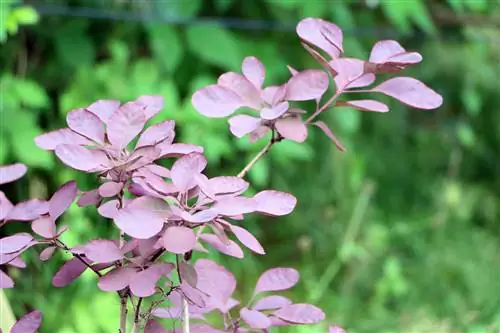
Wintering
The perennial wig bush can even survive icy temperatures of a maximum of -20 degrees. The younger a specimen, the more sensitive the plants are to cold temperatures. Even freshly planted shrubs are quite sensitive to cold and react negatively to night frost. To ensure that they do not suffer any damage over the cold winter months, young plants should ideally overwinter in a frost-free but cool place. Old and well-rooted bushes are more resistant, but in extreme frost there is also a need for additional winter protection in the form of a layer of brushwood. However, in our latitudes and the rather mild winters of recent years, such protection is rarely necessary. Other diseases can also affect the shrub. Other common diseases include powdery mildew, which can be combated by severe pruning or the use of fungicides.
Diseases and pests
With good care and an appropriate location, the wig bush proves to be extremely stubborn. It is rarely affected by pests or plants. However, the plant is relatively often affected by the so-called verticillium wilt, which at first glance is often confused with drought. The main symptoms of wilt include falling branches and wilting leaves despite sufficient watering. A piece of the bark can be removed for diagnosis. If the plant's water ducts are brownish in color, this indicates the disease.
The cause of the disease is a harmful fungus that is found in the soil. Once plants have been infected, they can no longer be cured. Optimal culture conditions can serve as a preventative protection against infection.
Toxicity
The wig bush is generally considered poisonous. Its toxicity is similar to poison ivy and the vinegar tree. The shrub is poisonous due to the flavones it contains, such as quercetin, which can cause skin irritation and irritation. Not all species contain this contact poison. Predominantly specimens with red leaves contain this poison.
Tip:
Due to its toxic properties, pruning should only be carried out with appropriately safe gloves.


